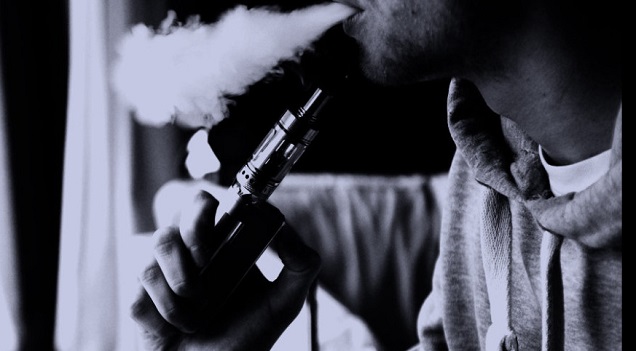
A new study looking at the effect of e-cigarette vapor on human airway cells has found no sign of toxicity, with the vapor-exposed cells doing about as well as the air-exposed ones. Although the study hasn't gotten much attention in the media, the (UK tabloid newspaper) the Mirror covered it, putting out a typically heavy-handed over-extrapolation of the results with the headline, “E-cigarette vapor has no toxic effect and is as safe as air, shock study claims” – almost as if they intended to show that bullshit about vaping can flow in two directions. Of course, the study doesn’t really mean e-cig vapor is “as safe as air” (because why would it be?), but it’s still excellent news for vapers, and although some will repeat the expected criticism due to the funding source – a tobacco company (gasp!) – solid science is solid science, no matter who funded it.
The Results at a Glance
- Researchers used a smoking robot and a 3D cell-culture designed to closely replicate human airways to test the toxicity of vapor in comparison to smoke and air.
- Two NJOY e-cigarettes were tested using an intense puffing regime. Cells were exposed to smoke or vapor for six hours, but there was 3.5 times more vapor by mass.
- The results show that smoke exposure reduced the cell viability to just 12 percent, but e-cig vapor had no impact on viability.
- Overall, e-cig vapor only affected the cells as much as air, but other evidence pretty much rules out the media claim that “e-cigarette vapor is as safe as air.”
- The study was funded by and conducted by employees of British American Tobacco, but appears to be reliable. Criticisms of research based on conflicts of interest alone are pretty much worthless.
The Study – Is E-Cig Vapor Toxic to Human Airway Cells?
The study (available in full, for free) aimed to investigate the toxicity of e-cigarette vapor in comparison to smoke and ordinary air using a fairly high-tech system. The setup involved a “smoking robot” (but, apparently, not Bender from Futurama) and a 3D model of the epithelial cells (the tissue that lines the airways) in the trachea and bronchi. The robot was used to produce a realistic exposure – similar to what you’d expect in a smoker or vaper’s respiratory tract – and the 3D model of the cells aims to provide a good approximation to real human airways for cell culture studies, with multiple layers and additional details such as cilia and mucus-excreting cells.
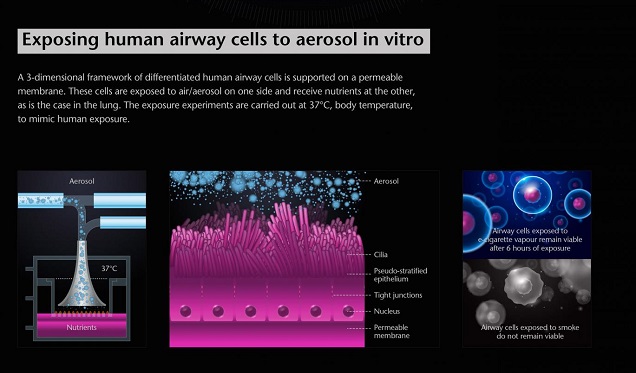
The researchers took the original samples from a 23-year old non-smoker, with no history of respiratory issues. Before the e-cig and smoke tests, they tested the system using known irritants and non-irritants, confirming that the model responded as it should.
The e-cigarettes tested were NJOY Kings (disposables), in Bold (45 mg/ml nicotine) and Menthol (30 mg/ml nicotine). Each device was puffed 60 times over the course of 30 minutes before being replaced, with the exposures to e-cigarette vapor and cigarette smoke each lasting 6 hours in total. The exposure to e-cig vapor was classed as intensive, with longer puffs and a much larger puff volume than the cigarette smoke tests, resulting in 3.5 times more vapor (by mass) reaching the cells than cigarette smoke.
What They Found – Cigarette Smoke Kills Airway Cells, Vapor Does Very Little
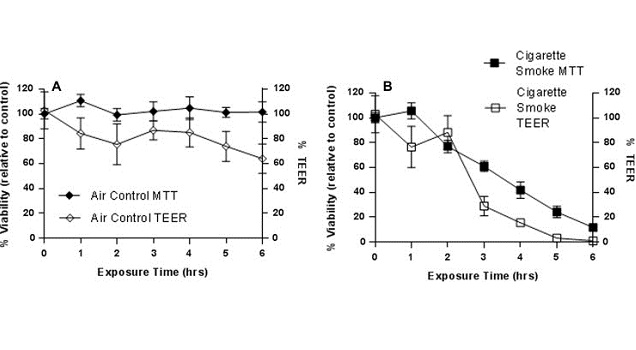
The overall findings can be summarized simply as: cigarette smoke killed the cells, but e-cig vapor did very little to them. Over the six hour period, the cells exposed to cigarette smoke declined in viability (meaning the number of healthy cells remaining) to just 12 percent, whereas the air-exposed cells remained at 100 percent viability. The researchers also looked at transepithelial electrical resistance (TEER), used as an indicator of cellular stress and an early sign of toxicity to cells, and expressed as a percentage of the pre-exposure value. For ordinary air, after 6 hours the TEER measurement was at 60 percent, but for cigarette smoke it went down to zero.
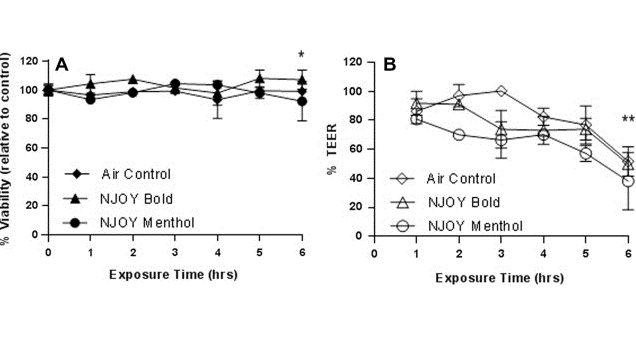
The vapor-exposed cells generally responded to testing more like the air-exposed cells than the smoke-exposed ones, with no significant difference in viability after six hours in comparison to the air-exposed cells from either tested e-cig. The TEER values showed a little more variation – with the air test finishing at 60 percent, compared to 38 percent for the NJOY menthol – but the differences weren’t statistically significant. This – as the Mirror tried to express – suggests that e-cigarette vapor has about the same effect on tracheal and bronchial cells as ordinary air.
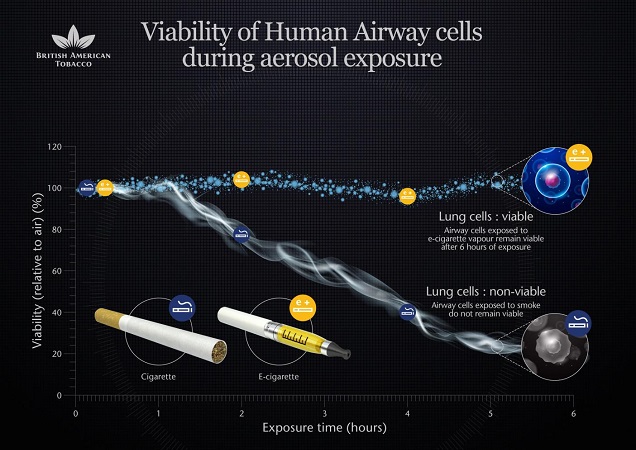
The comparison between the cells’ viability after exposure to cigarette smoke and e-cigarette vapor is the sort of thing that drives home the reduced-harm nature of e-cigarettes. Even with a much larger amount of e-cigarette vapor, the difference between the two is substantial. Michael Siegel commented that, “it adds additional evidence to support the contention that vaping is a lot safer than smoking.”
Is Vaping as Safe As Breathing Air? Or is it Just Pro-Vaping Media Nonsense?
As much as we’d like vaping to be as safe as breathing ordinary air, and as pleasant a change as it is to have some media outlets spewing pro-vaping junk, it must be said that it’s very unlikely that vaping is as safe as breathing. Other toxicological studies have found toxicity to cells, albeit at a much lower level than cigarette smoke and more dependent on the flavorings present than the base ingredients. The current study only assessed two flavors, and the other research indicating that flavorings have an important effect suggests that it’s a little soon to start claiming vaping is “as safe as air” to the cells.
The authors point out, though, that the different results observed in comparison to other studies could be due to the 3D tissue model used, which included multiple cell types that could interact, producing a much more representative model of real human exposure than “monolayer” culture studies.
However, all of the cells in this study came from a single donor, and there may be differences between donors that affect the results of such studies. Future studies using multiple donors would help to clarify whether the results of this research apply to all individuals, or whether the authors just “lucked out” in this test by having a resistant donor. And, of course, the test only lasted six hours, so it’s entirely possible that long-term exposure would have more serious consequences.
Overall though, there’s no reason to assume that vaping is as safe as breathing air. It could be, but with other evidence suggesting that vaping is worse for the lungs than breathing air and it having minor impacts on things like blood pressure – even though these findings aren’t particularly concerning – it’s unlikely that vaping is going to be as harmless as breathing. John Madden’s comparison between the toxic chemical emissions from e-cigs and those present in human breath and outdoor air found similar levels overall, but e-cig vapor does have more of them than the air you breathe.
Finally, it’s important to remember that this is just one result. Imagine how much caution you’d want people to have in interpreting the results of one study if it had found that vaping had a similar effect to tobacco cigarettes: that’s exactly how cautious you should be about assuming “safety” based on this one finding.
Why Conflicts of Interest Hardly Matter When Interpreting Research
This study was funded by British American Tobacco and conducted (in part) by its employees, which will undoubtedly lead many to dismiss it out of hand. As we briefly covered in our rough guide to spotting bad e-cigarette studies, while conflicts of interest give you a reason to scrutinize a set of results for potential issues, the presence of a conflict of interest pretty much means nothing in the absence of an issue with the methodology or some reason to think they’ve done something underhanded like fabricated data.
If you never trusted research funded by people with a vested interest in the outcome, you’d be in the difficult position of hardly ever being able to trust the results of drug trials, which are primarily funded by the pharmaceutical industry. The assumption might be true – there could be deception, spin or other tricks at play – but if you can’t identify what’s wrong and explain how it impacts the findings, you might as well not bother mentioning the conflict of interest. All research can be flawed, whether industry-funded or not, and all research should be scrutinized.
As the Electronic Cigarette Industry Trade Association's (ECITA) chief scientific officer Tom Pruen comments:
“While I'm sure that for many the source of the research will be a problem, of recent years the science conducted by the tobacco industry has been of very good quality, and despite the historic issues I wouldn't view it with any greater skepticism than research conducted elsewhere.”
Conclusion – More Great News for Vapers
So – despite some typically over-zealous reporting and some criticism to be expected due to the source of funding – the new study is more great news for vapers. Although the best way to reduce your risk is to neither vape nor smoke, the new finding adds further evidence that the risks associated with vaping are likely to be very small, and almost certainly much less than the risks of smoking. We shouldn’t go all tabloid about it and claim vaping is as safe as breathing air, but every new finding like this gives us a little more cause for cautious optimism.

